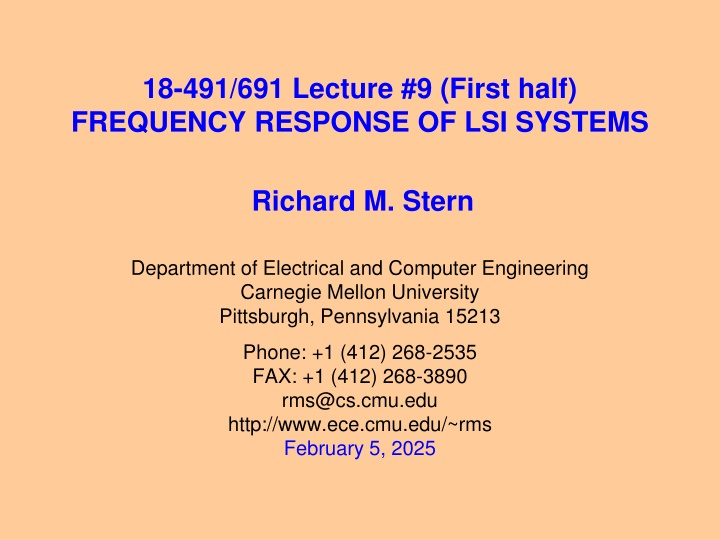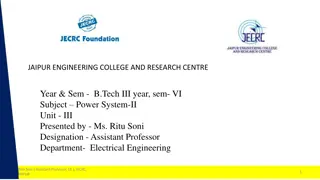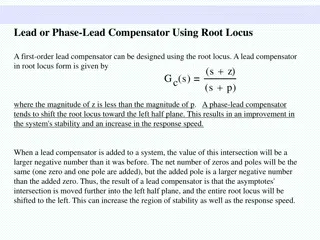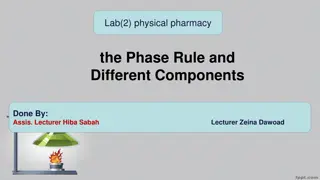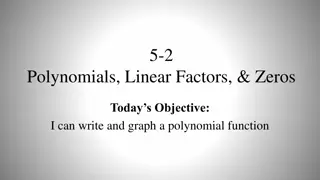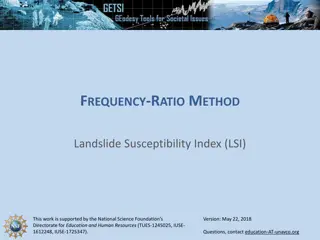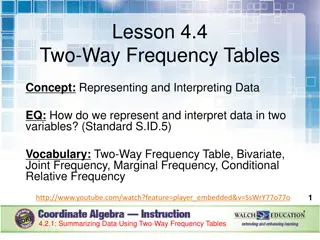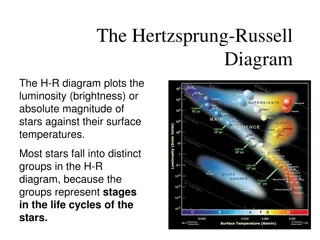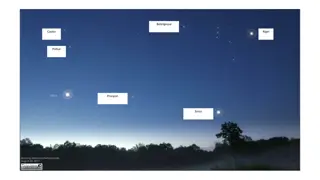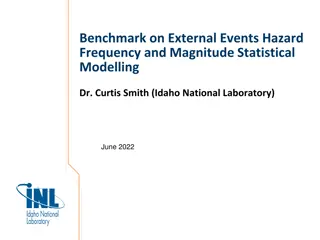Frequency Response of LSI Systems: Magnitude, Phase, Poles, and Zeros
Frequency response of LSI systems in Z-transform form, examining the relationship between the DTFT magnitude/phase and pole/zero locations in the Z-plane. Delve into special cases like all-pass, minimum/maximum-phase, and linear-phase systems through difference equations, Z-transforms, and discrete-time Fourier transforms.
Download Presentation

Please find below an Image/Link to download the presentation.
The content on the website is provided AS IS for your information and personal use only. It may not be sold, licensed, or shared on other websites without obtaining consent from the author.If you encounter any issues during the download, it is possible that the publisher has removed the file from their server.
You are allowed to download the files provided on this website for personal or commercial use, subject to the condition that they are used lawfully. All files are the property of their respective owners.
The content on the website is provided AS IS for your information and personal use only. It may not be sold, licensed, or shared on other websites without obtaining consent from the author.
E N D
Presentation Transcript
18-491/691 Lecture #9 (First half) FREQUENCY RESPONSE OF LSI SYSTEMS Richard M. Stern Department of Electrical and Computer Engineering Carnegie Mellon University Pittsburgh, Pennsylvania 15213 Phone: +1 (412) 268-2535 FAX: +1 (412) 268-3890 rms@cs.cmu.edu http://www.ece.cmu.edu/~rms February 5, 2025
Introduction Last week we discussed the Z-transform at length, including the unit sample response, ROC, inverse Z-transforms and comparison to the DTFT and difference equations Today we will discuss the frequency response of LSI systems and how it relates to the system function in Z-transform form Specifically we will Relate magnitude and phase of DTFT to locations of poles and zeros in z-plane Discuss several important special cases: All-pass systems Minimum/maximum-phase systems Linear phase systems Carnegie Mellon Slide 2 ECE Department
Review - Difference equations and Z- transforms characterizing LSI systems y[n] x[n] h[n] Many LSI systems are characterized by difference equations of the form ak k=0 k=0 N M y[n-k] = bkx[n -k] They produce system functions of the form M bkz-k H(z) =Y(z) k=0 N X(z)= akz-k k=0 Comment: This notation is a little different from last week s (but consistent with the text in Chap, 5) Carnegie Mellon Slide 3 ECE Department
Difference equations and Z-transforms characterizing LSI systems (cont.) M bkz-k H(z) =Y(z) k=0 N X(z)= akz-k k=0 Comments: LSI systems characterized by difference equations produce z- transforms that are ratios of polynomials in z or z-1 The zeros are the values of zthat cause the numerator to equal zero, and the poles are the values of z that cause the denominator polynomial to equal zero Carnegie Mellon Slide 4 ECE Department
Discrete-time Fourier transforms and the Z-transform Recall that the DTFT is obtained by evaluating the z-transform along the contour H(ejw) = H(z)z=ejw z = ejw The DTFT is generally complex and typically characterized by its magnitude and phase: M bke-jwk k=0 akejwk k=0 = H(ejw)ej H(ejw) H(ejw) = N Carnegie Mellon Slide 5 ECE Department
Obtaining the magnitude and phase of the DTFT by factoring the z-transform Factoring the z-transform: M M bkz-k (1-ckz-1) k=1 (1- dkz-1) k=1 b0 a0 k=0 N H(z) = = N akz-k k=0 ck dk Comment: The constants and are the zeros and poles of the system respectively Carnegie Mellon Slide 6 ECE Department
So what do those terms mean, anyway? Convert into a polynomial in z by multiplying numerator and denominator by largest power of z: (1-ckz-1) k=1 (1- dkz-1) k=1 M M (z -ck) k=1 N (z-ck) b0 a0 = zN-M b0 H(z) = N a0 (z -dk) k=1 Now consider one of the numerator terms, Note that the vector (z-ck) is the length of line from the zero to the current value of z or the distance from the zero to the unit circle. Carnegie Mellon Slide 7 ECE Department
Finding the magnitude of the DTFT M (z -ck) k=1 N H(ejw) = H(z)z=ejw = zN-M b0 a0 (z -dk) k=1 z=ejw Magnitude: M M (z-ck) k=1 N (z -ck) H(ejw) = H(z)z=ejw = zN-Mb0 =b0 k=1 M a0 a0 (z -dk) k=1 (z -dk) z=ejw z=ejw k=1 Comment: The magnitude is the product of magnitudes from zeros divided by product of magnitudes from poles Carnegie Mellon Slide 8 ECE Department
Finding the phase of the DTFT M (z -ck) k=1 N H(ejw) = H(z)z=ejw = zN-M b0 a0 (z -dk) k=1 z=ejw Phase: M N H(ejw)z=ejw=w(N - M)+ b0 + (z -ck) k=1 - (z -dk) k=1 a0 z=ejw Comment: The magnitude is the sum of the angles from the zeros minus the sums of the angles from the poles Carnegie Mellon Slide 9 ECE Department
Example 1: Unit time delay H(z) = z-1 Pole-zero pattern: Frequency response: Carnegie Mellon Slide 10 ECE Department
Example 2: Decaying exponential sample response 1 H(z) = 1-az-1 Pole-zero pattern: Frequency response: Carnegie Mellon Slide 11 ECE Department
Example 3: Notch filter (z-ejp /4)(z-e-jp /4) (z-.95ejp /4)(z-.95e-jp /4) H(z) = Pole-zero pattern: Frequency response: Carnegie Mellon Slide 12 ECE Department
Summary (first half) The DTFT is obtained by evaluating the z-transform along the unit circle As we walk along the unit circle, The magnitude of the DTFT is proportional of the product of the distances from the zeros divided by the product of the distances from the poles The phase of the DTFT is (within additive constants) the sum of the angles from the zeros minus the sum of the angles from the poles After the break: Allpass systems Minimum-phase and maximum-phase systems Linear-phase systems Carnegie Mellon Slide 13 ECE Department
Special types of LSI systems We can get additional insight about the frequency-response behavior of LSI systems by considering three special cases: Allpass systems Systems with minimum or maximum phase Linear-phase systems Carnegie Mellon Slide 14 ECE Department
All-pass systems H(z) =z-1-a* 1-az-1 Consider an LSI system with system function with complex .. a = rejq Let z = rejq Then there is a pole at z =1 rejq And a zero at Comment: We refer to this configuration as mirror image poles and zeros Carnegie Mellon Slide 15 ECE Department
Frequency response of all-pass systems H(z) =z-1-a* 1-az-1; z =ejw,a = rejq Obtaining magnitude of frequency response directly: H(ejw)2= H(ejw)H*(ejw) =(e-jw-re-jq) (ejw-rejq) (1-re- jqejw) (1-rejqe-jw) =(1-rej(q-w)-re-j(q-w)+r2) (1-re-j(q-w)-rej(q-w)+r2) =1 Carnegie Mellon Slide 16 ECE Department
Frequency response of all-pass systems All-pass systems have mirror-image sets of poles and zeros All-pass systems have a frequency response with constant magnitude Carnegie Mellon Slide 17 ECE Department
System functions with the same magnitude can have more than one phase function Consider two systems: System 1: pole at .75, zero at .5 System 2: pole at .75, zero at 2 Comment: System 2 can be obtained by cascading System 1 with an all-pass system with a pole at .5 and a zero at 2. Hence the two systems have the same magnitude. Carnegie Mellon Slide 18 ECE Department
But what about the two phase responses? Response of System 1: Response of System 2: Comment: Systems have same magnitude, but System 2 has much greater phase shift Carnegie Mellon Slide 19 ECE Department
General comments on phase responses System 1 has much less phase shift than System 2; this is generally considered to be good System 1 has its zero inside unit circle; System 2 has zero its zero outside the unit circle A system is considered to be of minimum phase if all of its zeros and all poles lie inside the unit circle A system is considered to be of maximum phase if all of its zeros and all poles lie outside the unit circle Systems with more than one zero might have neither minimum nor maximum phase Carnegie Mellon Slide 20 ECE Department
A digression: Symmetry properties of DTFTs Recall from DTFT properties: x[n] X(ejw) x[-n] X(e- jw) x*[n] X*(e-jw) x[n]= x[-n] X(ejw) = X(e-jw) even even x[n]= -x[-n] X(ejw) = -X(e-jw) odd odd x[n]= x*[n] X(ejw) = X*(e-jw) real Hermitian symmetric If then and ... Carnegie Mellon Slide 21 ECE Department
Consequences of Hermitian symmetry X(ejw) = X*(e-jw) If Re[X(ejw)] is even Im[X(ejw)] is odd X(ejw) is even Then X(ejw) is odd If x[n] is real and even, X(ejw) will be real and even and if x[n] is real and odd, X(ejw) will be imaginary and odd And Carnegie Mellon Slide 22 ECE Department
Zero phase systems Consider an LSI system with an even unit sample response: DTFT is Comments: Frequency response is real, so system has zero phase shift This is to be expected since unit sample response is real and even Carnegie Mellon Slide 23 ECE Department
Linear phase systems Now delay the system s sample response to make it causal: DTFT is now Comment: Frequency response now exhibits linear phase shift Carnegie Mellon Slide 24 ECE Department
An additional comment or two The system on the previous page exhibits linear phase shift This is also reasonable, since the corresponding sample response can be thought of as a zero-phase sample response that undergoes a time shift by two samples (producing a linear phase shift in the frequency domain) Another way to think about this is as a sample response that is even symmetric about the sample n=2 Linear phase is generally considered to be more desirable than non-linear phase shift If a linear-phase system is causal, it must be finite in duration. (The current example has only 5 nonzero samples.) Carnegie Mellon Slide 25 ECE Department
Another example of a linear phase systems Now let s consider a similar system but with an even number of sample points: DTFT is Carnegie Mellon Slide 26 ECE Department
Comments on the last system The system on the previous page also exhibits linear phase shift In this case the corresponding sample response can be thought of as a zero-phase sample response that undergoes a time shift by 2.5 samples In this case the unit sample response is symmetric about the point n=2.5 This type of system exhibits generalized linear phase , because the unit sample response is symmetric about a location that is between two integers Carnegie Mellon Slide 27 ECE Department
Zeros of linear phase systems Let us now consider again the z-transform of the system of Slide 24: Zeros are obtained easily by solving: Multiplying both sides by z-4 produces Note that if z0 is a zero of H(z), z0-1 is as well. These are conjugate reciprocal locations: Carnegie Mellon Slide 28 ECE Department
Possible zero locations for linear-phase systems Carnegie Mellon Slide 29 ECE Department
Four types of linear-phase systems Oppenheim and Schafer refer to four types systems with generalized linear phase. All have sample points that are symmetric about its midpoint. Type I: Odd number of samples, even symmetry Type II: Even number of samples, even symmetry Type III: Odd number of samples, odd symmetry Type IV: Even number of samples, odd symmetry Carnegie Mellon Slide 30 ECE Department
Summary of second half of lecture All-pass systems have poles and zeros in mirror-image pairs Minimum phase causal and stable systems have all zeros (as well as all poles) inside the unit circle Maximum phase causal and stable systems have all zeros and all poles outside the unit circle Linear phase systems have unit sample responses that are symmetric about their midpoint (which may lie between two sample points Carnegie Mellon Slide 31 ECE Department
